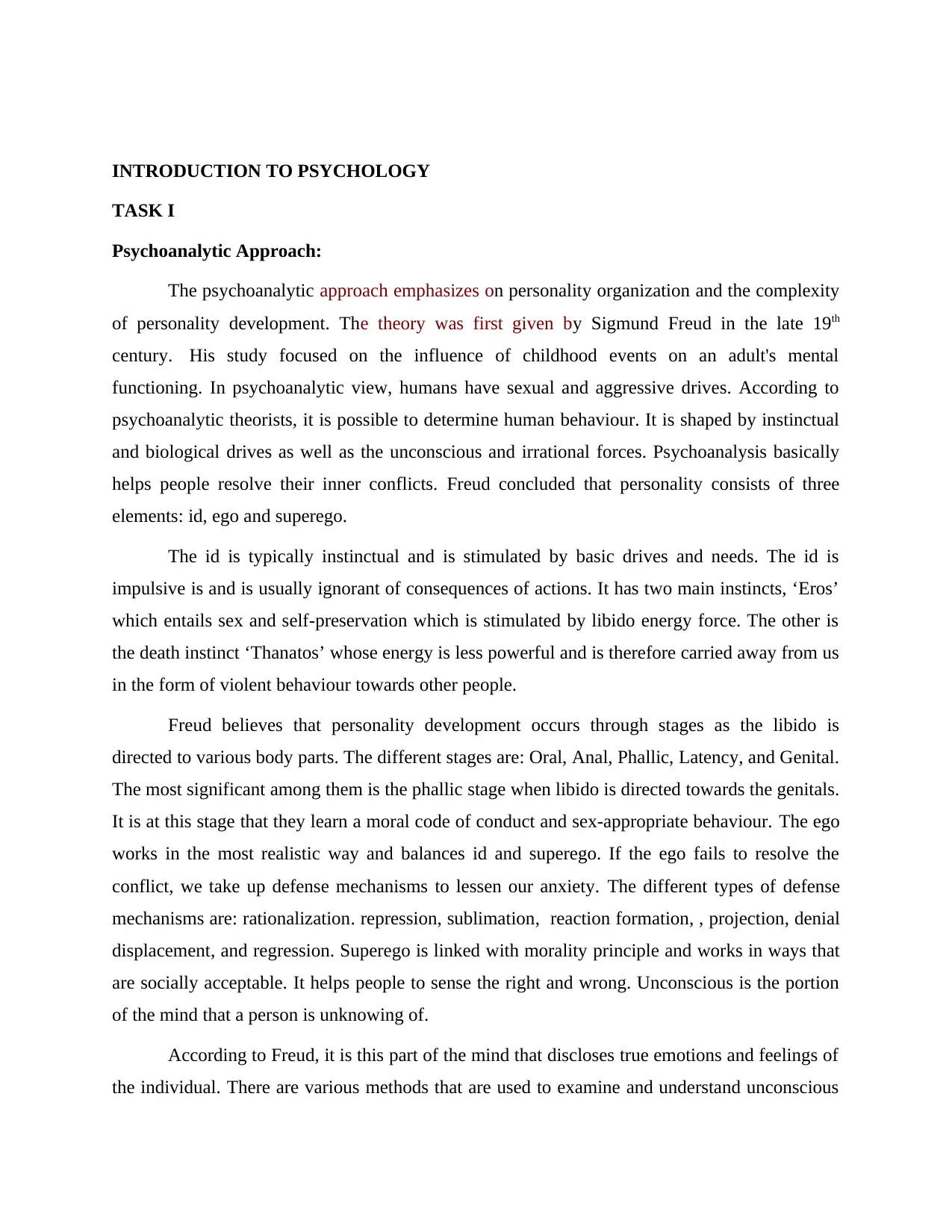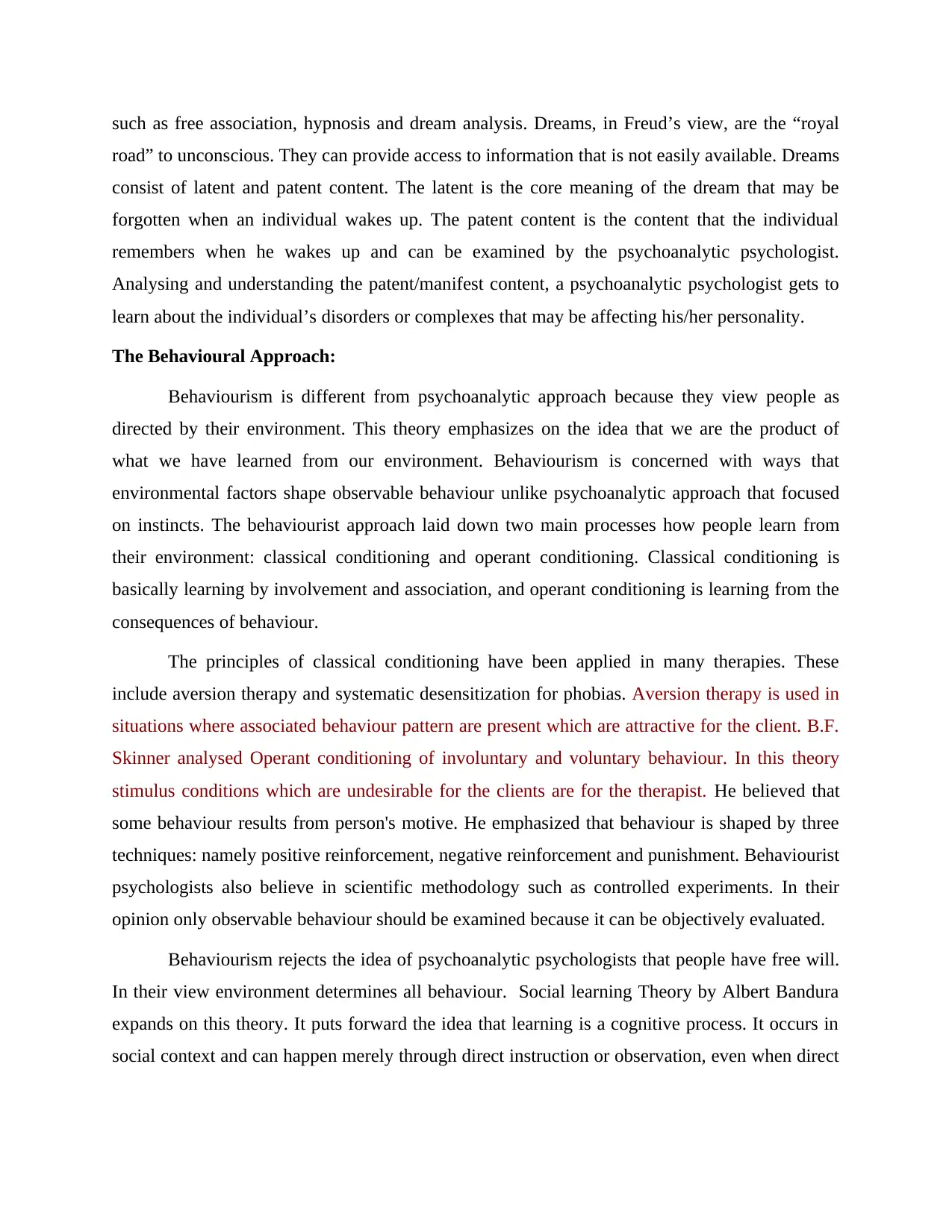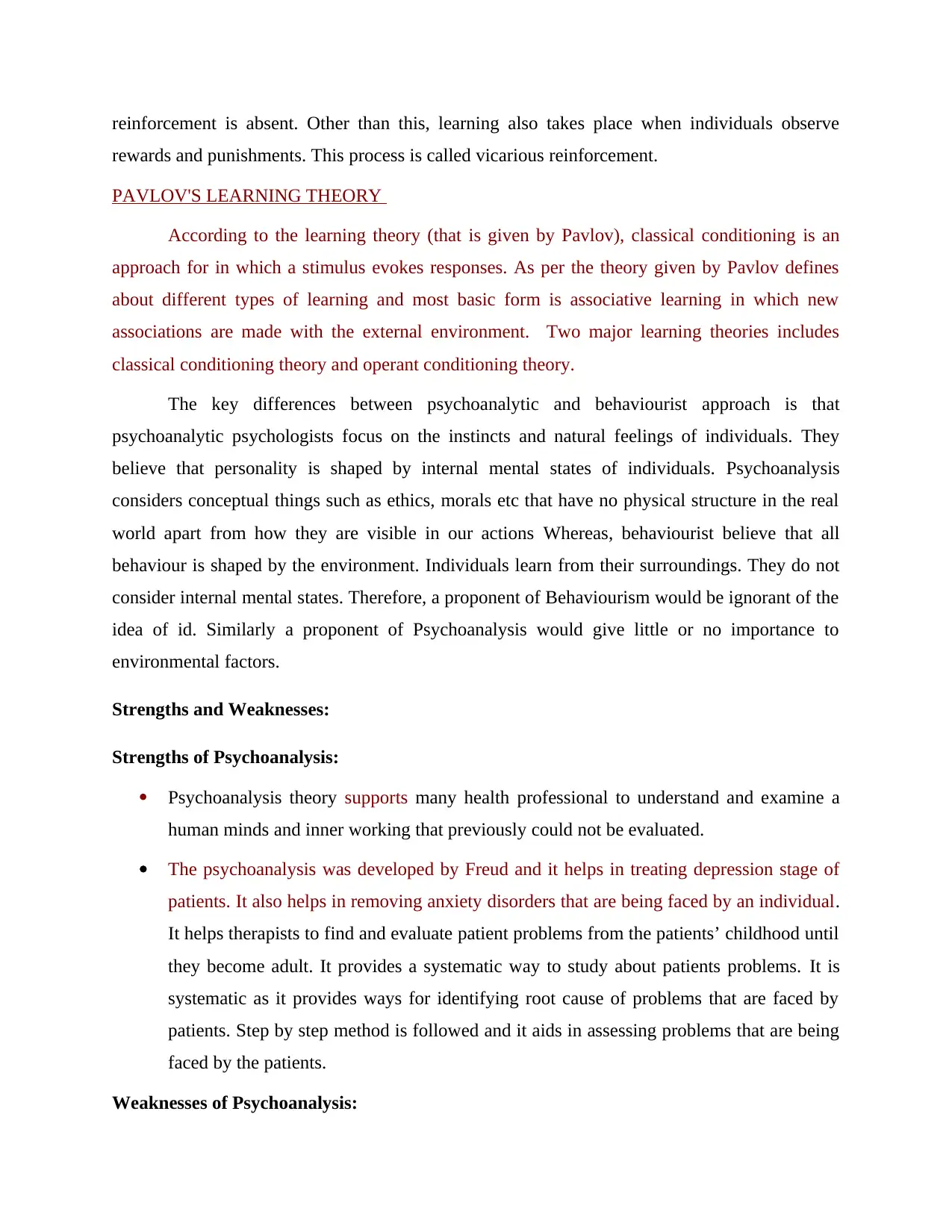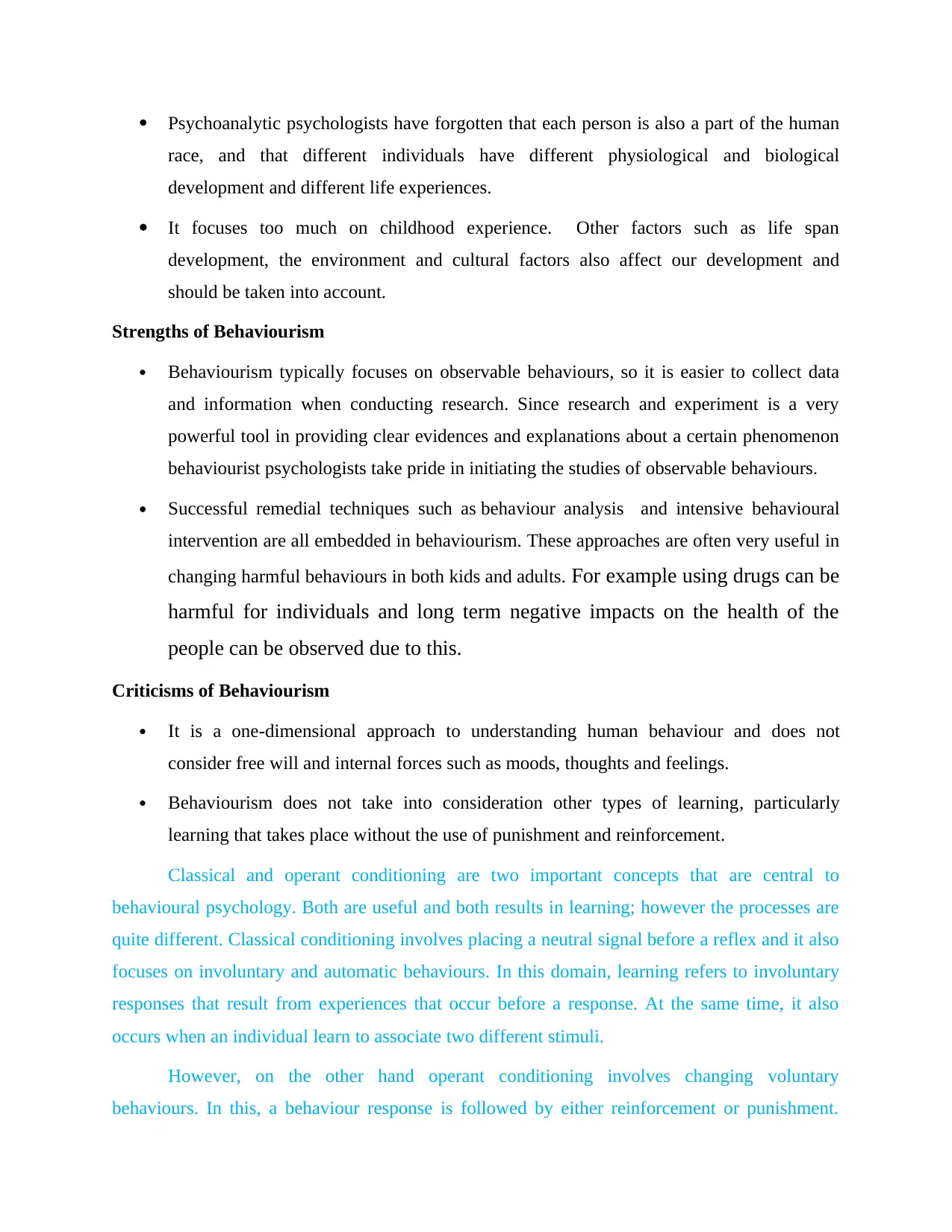Introduction to Psychology: Psychoanalytic Approach and Behavioural Approach
VerifiedAdded on 2023/04/17
|5
|1384
|267
AI Summary
This document provides an introduction to psychology, focusing on the psychoanalytic approach and behavioural approach. It explains the concepts of personality development, unconscious mind, and different types of conditioning. It also discusses the strengths and weaknesses of psychoanalysis and behaviourism.
Contribute Materials
Your contribution can guide someone’s learning journey. Share your
documents today.

INTRODUCTION TO PSYCHOLOGY
TASK I
Psychoanalytic Approach:
The psychoanalytic approach emphasizes on personality organization and the complexity
of personality development. The theory was first given by Sigmund Freud in the late 19th
century. His study focused on the influence of childhood events on an adult's mental
functioning. In psychoanalytic view, humans have sexual and aggressive drives. According to
psychoanalytic theorists, it is possible to determine human behaviour. It is shaped by instinctual
and biological drives as well as the unconscious and irrational forces. Psychoanalysis basically
helps people resolve their inner conflicts. Freud concluded that personality consists of three
elements: id, ego and superego.
The id is typically instinctual and is stimulated by basic drives and needs. The id is
impulsive is and is usually ignorant of consequences of actions. It has two main instincts, ‘Eros’
which entails sex and self-preservation which is stimulated by libido energy force. The other is
the death instinct ‘Thanatos’ whose energy is less powerful and is therefore carried away from us
in the form of violent behaviour towards other people.
Freud believes that personality development occurs through stages as the libido is
directed to various body parts. The different stages are: Oral, Anal, Phallic, Latency, and Genital.
The most significant among them is the phallic stage when libido is directed towards the genitals.
It is at this stage that they learn a moral code of conduct and sex-appropriate behaviour. The ego
works in the most realistic way and balances id and superego. If the ego fails to resolve the
conflict, we take up defense mechanisms to lessen our anxiety. The different types of defense
mechanisms are: rationalization. repression, sublimation, reaction formation, , projection, denial
displacement, and regression. Superego is linked with morality principle and works in ways that
are socially acceptable. It helps people to sense the right and wrong. Unconscious is the portion
of the mind that a person is unknowing of.
According to Freud, it is this part of the mind that discloses true emotions and feelings of
the individual. There are various methods that are used to examine and understand unconscious
TASK I
Psychoanalytic Approach:
The psychoanalytic approach emphasizes on personality organization and the complexity
of personality development. The theory was first given by Sigmund Freud in the late 19th
century. His study focused on the influence of childhood events on an adult's mental
functioning. In psychoanalytic view, humans have sexual and aggressive drives. According to
psychoanalytic theorists, it is possible to determine human behaviour. It is shaped by instinctual
and biological drives as well as the unconscious and irrational forces. Psychoanalysis basically
helps people resolve their inner conflicts. Freud concluded that personality consists of three
elements: id, ego and superego.
The id is typically instinctual and is stimulated by basic drives and needs. The id is
impulsive is and is usually ignorant of consequences of actions. It has two main instincts, ‘Eros’
which entails sex and self-preservation which is stimulated by libido energy force. The other is
the death instinct ‘Thanatos’ whose energy is less powerful and is therefore carried away from us
in the form of violent behaviour towards other people.
Freud believes that personality development occurs through stages as the libido is
directed to various body parts. The different stages are: Oral, Anal, Phallic, Latency, and Genital.
The most significant among them is the phallic stage when libido is directed towards the genitals.
It is at this stage that they learn a moral code of conduct and sex-appropriate behaviour. The ego
works in the most realistic way and balances id and superego. If the ego fails to resolve the
conflict, we take up defense mechanisms to lessen our anxiety. The different types of defense
mechanisms are: rationalization. repression, sublimation, reaction formation, , projection, denial
displacement, and regression. Superego is linked with morality principle and works in ways that
are socially acceptable. It helps people to sense the right and wrong. Unconscious is the portion
of the mind that a person is unknowing of.
According to Freud, it is this part of the mind that discloses true emotions and feelings of
the individual. There are various methods that are used to examine and understand unconscious
Secure Best Marks with AI Grader
Need help grading? Try our AI Grader for instant feedback on your assignments.

such as free association, hypnosis and dream analysis. Dreams, in Freud’s view, are the “royal
road” to unconscious. They can provide access to information that is not easily available. Dreams
consist of latent and patent content. The latent is the core meaning of the dream that may be
forgotten when an individual wakes up. The patent content is the content that the individual
remembers when he wakes up and can be examined by the psychoanalytic psychologist.
Analysing and understanding the patent/manifest content, a psychoanalytic psychologist gets to
learn about the individual’s disorders or complexes that may be affecting his/her personality.
The Behavioural Approach:
Behaviourism is different from psychoanalytic approach because they view people as
directed by their environment. This theory emphasizes on the idea that we are the product of
what we have learned from our environment. Behaviourism is concerned with ways that
environmental factors shape observable behaviour unlike psychoanalytic approach that focused
on instincts. The behaviourist approach laid down two main processes how people learn from
their environment: classical conditioning and operant conditioning. Classical conditioning is
basically learning by involvement and association, and operant conditioning is learning from the
consequences of behaviour.
The principles of classical conditioning have been applied in many therapies. These
include aversion therapy and systematic desensitization for phobias. Aversion therapy is used in
situations where associated behaviour pattern are present which are attractive for the client. B.F.
Skinner analysed Operant conditioning of involuntary and voluntary behaviour. In this theory
stimulus conditions which are undesirable for the clients are for the therapist. He believed that
some behaviour results from person's motive. He emphasized that behaviour is shaped by three
techniques: namely positive reinforcement, negative reinforcement and punishment. Behaviourist
psychologists also believe in scientific methodology such as controlled experiments. In their
opinion only observable behaviour should be examined because it can be objectively evaluated.
Behaviourism rejects the idea of psychoanalytic psychologists that people have free will.
In their view environment determines all behaviour. Social learning Theory by Albert Bandura
expands on this theory. It puts forward the idea that learning is a cognitive process. It occurs in
social context and can happen merely through direct instruction or observation, even when direct
road” to unconscious. They can provide access to information that is not easily available. Dreams
consist of latent and patent content. The latent is the core meaning of the dream that may be
forgotten when an individual wakes up. The patent content is the content that the individual
remembers when he wakes up and can be examined by the psychoanalytic psychologist.
Analysing and understanding the patent/manifest content, a psychoanalytic psychologist gets to
learn about the individual’s disorders or complexes that may be affecting his/her personality.
The Behavioural Approach:
Behaviourism is different from psychoanalytic approach because they view people as
directed by their environment. This theory emphasizes on the idea that we are the product of
what we have learned from our environment. Behaviourism is concerned with ways that
environmental factors shape observable behaviour unlike psychoanalytic approach that focused
on instincts. The behaviourist approach laid down two main processes how people learn from
their environment: classical conditioning and operant conditioning. Classical conditioning is
basically learning by involvement and association, and operant conditioning is learning from the
consequences of behaviour.
The principles of classical conditioning have been applied in many therapies. These
include aversion therapy and systematic desensitization for phobias. Aversion therapy is used in
situations where associated behaviour pattern are present which are attractive for the client. B.F.
Skinner analysed Operant conditioning of involuntary and voluntary behaviour. In this theory
stimulus conditions which are undesirable for the clients are for the therapist. He believed that
some behaviour results from person's motive. He emphasized that behaviour is shaped by three
techniques: namely positive reinforcement, negative reinforcement and punishment. Behaviourist
psychologists also believe in scientific methodology such as controlled experiments. In their
opinion only observable behaviour should be examined because it can be objectively evaluated.
Behaviourism rejects the idea of psychoanalytic psychologists that people have free will.
In their view environment determines all behaviour. Social learning Theory by Albert Bandura
expands on this theory. It puts forward the idea that learning is a cognitive process. It occurs in
social context and can happen merely through direct instruction or observation, even when direct

reinforcement is absent. Other than this, learning also takes place when individuals observe
rewards and punishments. This process is called vicarious reinforcement.
PAVLOV'S LEARNING THEORY
According to the learning theory (that is given by Pavlov), classical conditioning is an
approach for in which a stimulus evokes responses. As per the theory given by Pavlov defines
about different types of learning and most basic form is associative learning in which new
associations are made with the external environment. Two major learning theories includes
classical conditioning theory and operant conditioning theory.
The key differences between psychoanalytic and behaviourist approach is that
psychoanalytic psychologists focus on the instincts and natural feelings of individuals. They
believe that personality is shaped by internal mental states of individuals. Psychoanalysis
considers conceptual things such as ethics, morals etc that have no physical structure in the real
world apart from how they are visible in our actions Whereas, behaviourist believe that all
behaviour is shaped by the environment. Individuals learn from their surroundings. They do not
consider internal mental states. Therefore, a proponent of Behaviourism would be ignorant of the
idea of id. Similarly a proponent of Psychoanalysis would give little or no importance to
environmental factors.
Strengths and Weaknesses:
Strengths of Psychoanalysis:
Psychoanalysis theory supports many health professional to understand and examine a
human minds and inner working that previously could not be evaluated.
The psychoanalysis was developed by Freud and it helps in treating depression stage of
patients. It also helps in removing anxiety disorders that are being faced by an individual.
It helps therapists to find and evaluate patient problems from the patients’ childhood until
they become adult. It provides a systematic way to study about patients problems. It is
systematic as it provides ways for identifying root cause of problems that are faced by
patients. Step by step method is followed and it aids in assessing problems that are being
faced by the patients.
Weaknesses of Psychoanalysis:
rewards and punishments. This process is called vicarious reinforcement.
PAVLOV'S LEARNING THEORY
According to the learning theory (that is given by Pavlov), classical conditioning is an
approach for in which a stimulus evokes responses. As per the theory given by Pavlov defines
about different types of learning and most basic form is associative learning in which new
associations are made with the external environment. Two major learning theories includes
classical conditioning theory and operant conditioning theory.
The key differences between psychoanalytic and behaviourist approach is that
psychoanalytic psychologists focus on the instincts and natural feelings of individuals. They
believe that personality is shaped by internal mental states of individuals. Psychoanalysis
considers conceptual things such as ethics, morals etc that have no physical structure in the real
world apart from how they are visible in our actions Whereas, behaviourist believe that all
behaviour is shaped by the environment. Individuals learn from their surroundings. They do not
consider internal mental states. Therefore, a proponent of Behaviourism would be ignorant of the
idea of id. Similarly a proponent of Psychoanalysis would give little or no importance to
environmental factors.
Strengths and Weaknesses:
Strengths of Psychoanalysis:
Psychoanalysis theory supports many health professional to understand and examine a
human minds and inner working that previously could not be evaluated.
The psychoanalysis was developed by Freud and it helps in treating depression stage of
patients. It also helps in removing anxiety disorders that are being faced by an individual.
It helps therapists to find and evaluate patient problems from the patients’ childhood until
they become adult. It provides a systematic way to study about patients problems. It is
systematic as it provides ways for identifying root cause of problems that are faced by
patients. Step by step method is followed and it aids in assessing problems that are being
faced by the patients.
Weaknesses of Psychoanalysis:

Psychoanalytic psychologists have forgotten that each person is also a part of the human
race, and that different individuals have different physiological and biological
development and different life experiences.
It focuses too much on childhood experience. Other factors such as life span
development, the environment and cultural factors also affect our development and
should be taken into account.
Strengths of Behaviourism
Behaviourism typically focuses on observable behaviours, so it is easier to collect data
and information when conducting research. Since research and experiment is a very
powerful tool in providing clear evidences and explanations about a certain phenomenon
behaviourist psychologists take pride in initiating the studies of observable behaviours.
Successful remedial techniques such as behaviour analysis and intensive behavioural
intervention are all embedded in behaviourism. These approaches are often very useful in
changing harmful behaviours in both kids and adults. For example using drugs can be
harmful for individuals and long term negative impacts on the health of the
people can be observed due to this.
Criticisms of Behaviourism
It is a one-dimensional approach to understanding human behaviour and does not
consider free will and internal forces such as moods, thoughts and feelings.
Behaviourism does not take into consideration other types of learning, particularly
learning that takes place without the use of punishment and reinforcement.
Classical and operant conditioning are two important concepts that are central to
behavioural psychology. Both are useful and both results in learning; however the processes are
quite different. Classical conditioning involves placing a neutral signal before a reflex and it also
focuses on involuntary and automatic behaviours. In this domain, learning refers to involuntary
responses that result from experiences that occur before a response. At the same time, it also
occurs when an individual learn to associate two different stimuli.
However, on the other hand operant conditioning involves changing voluntary
behaviours. In this, a behaviour response is followed by either reinforcement or punishment.
race, and that different individuals have different physiological and biological
development and different life experiences.
It focuses too much on childhood experience. Other factors such as life span
development, the environment and cultural factors also affect our development and
should be taken into account.
Strengths of Behaviourism
Behaviourism typically focuses on observable behaviours, so it is easier to collect data
and information when conducting research. Since research and experiment is a very
powerful tool in providing clear evidences and explanations about a certain phenomenon
behaviourist psychologists take pride in initiating the studies of observable behaviours.
Successful remedial techniques such as behaviour analysis and intensive behavioural
intervention are all embedded in behaviourism. These approaches are often very useful in
changing harmful behaviours in both kids and adults. For example using drugs can be
harmful for individuals and long term negative impacts on the health of the
people can be observed due to this.
Criticisms of Behaviourism
It is a one-dimensional approach to understanding human behaviour and does not
consider free will and internal forces such as moods, thoughts and feelings.
Behaviourism does not take into consideration other types of learning, particularly
learning that takes place without the use of punishment and reinforcement.
Classical and operant conditioning are two important concepts that are central to
behavioural psychology. Both are useful and both results in learning; however the processes are
quite different. Classical conditioning involves placing a neutral signal before a reflex and it also
focuses on involuntary and automatic behaviours. In this domain, learning refers to involuntary
responses that result from experiences that occur before a response. At the same time, it also
occurs when an individual learn to associate two different stimuli.
However, on the other hand operant conditioning involves changing voluntary
behaviours. In this, a behaviour response is followed by either reinforcement or punishment.
Secure Best Marks with AI Grader
Need help grading? Try our AI Grader for instant feedback on your assignments.

Reinforcement also follows a behaviour that causes the behaviour to increase; but if behaviour is
followed by punishment, then it will decrease.
followed by punishment, then it will decrease.
1 out of 5
Your All-in-One AI-Powered Toolkit for Academic Success.
+13062052269
info@desklib.com
Available 24*7 on WhatsApp / Email
![[object Object]](/_next/static/media/star-bottom.7253800d.svg)
Unlock your academic potential
© 2024 | Zucol Services PVT LTD | All rights reserved.


